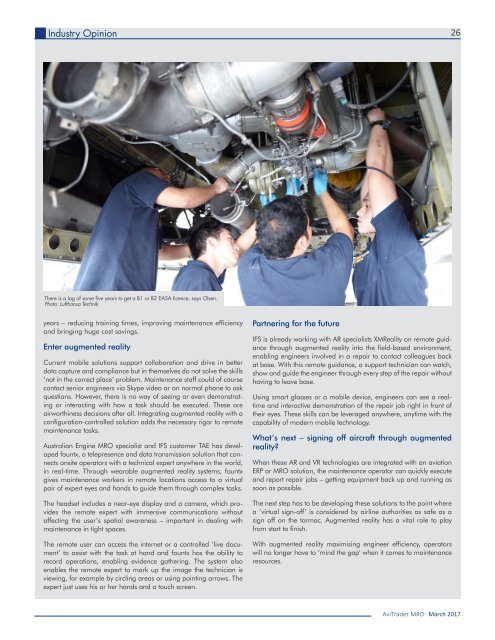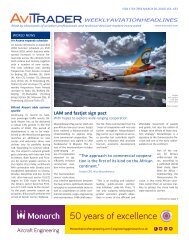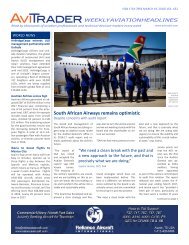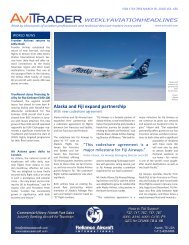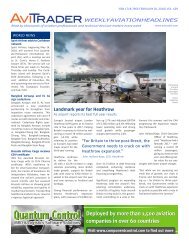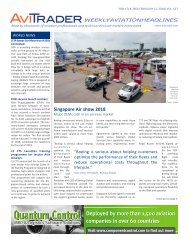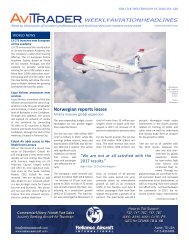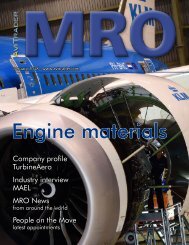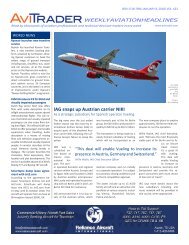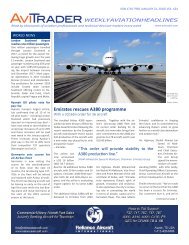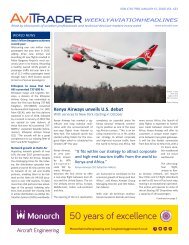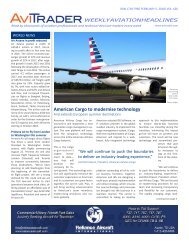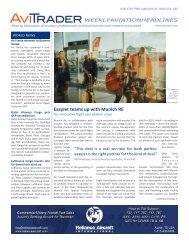AviTrader MRO Magazine 2017-03
AviTrader MRO Magazine 2017-03
AviTrader MRO Magazine 2017-03
Create successful ePaper yourself
Turn your PDF publications into a flip-book with our unique Google optimized e-Paper software.
Industry Opinion<br />
26<br />
There is a lag of some five years to get a B1 or B2 EASA licence, says Olsen.<br />
Photo: Lufthansa Technik<br />
years – reducing training times, improving maintenance efficiency<br />
and bringing huge cost savings.<br />
Enter augmented reality<br />
Current mobile solutions support collaboration and drive in better<br />
data capture and compliance but in themselves do not solve the skills<br />
‘not in the correct place’ problem. Maintenance staff could of course<br />
contact senior engineers via Skype video or on normal phone to ask<br />
questions. However, there is no way of seeing or even demonstrating<br />
or interacting with how a task should be executed. These are<br />
airworthiness decisions after all. Integrating augmented reality with a<br />
configuration-controlled solution adds the necessary rigor to remote<br />
maintenance tasks.<br />
Australian Engine <strong>MRO</strong> specialist and IFS customer TAE has developed<br />
fountx, a telepresence and data transmission solution that connects<br />
onsite operators with a technical expert anywhere in the world,<br />
in real-time. Through wearable augmented reality systems, fountx<br />
gives maintenance workers in remote locations access to a virtual<br />
pair of expert eyes and hands to guide them through complex tasks.<br />
The headset includes a near-eye display and a camera, which provides<br />
the remote expert with immersive communications without<br />
affecting the user’s spatial awareness – important in dealing with<br />
maintenance in tight spaces.<br />
The remote user can access the internet or a controlled ‘live document’<br />
to assist with the task at hand and fountx has the ability to<br />
record operations, enabling evidence gathering. The system also<br />
enables the remote expert to mark up the image the technician is<br />
viewing, for example by circling areas or using pointing arrows. The<br />
expert just uses his or her hands and a touch screen.<br />
Partnering for the future<br />
IFS is already working with AR specialists XMReality on remote guidance<br />
through augmented reality into the field-based environment,<br />
enabling engineers involved in a repair to contact colleagues back<br />
at base. With this remote guidance, a support technician can watch,<br />
show and guide the engineer through every step of the repair without<br />
having to leave base.<br />
Using smart glasses or a mobile device, engineers can see a realtime<br />
and interactive demonstration of the repair job right in front of<br />
their eyes. These skills can be leveraged anywhere, anytime with the<br />
capability of modern mobile technology.<br />
What’s next – signing off aircraft through augmented<br />
reality?<br />
When these AR and VR technologies are integrated with an aviation<br />
ERP or <strong>MRO</strong> solution, the maintenance operator can quickly execute<br />
and report repair jobs – getting equipment back up and running as<br />
soon as possible.<br />
The next step has to be developing these solutions to the point where<br />
a ‘virtual sign-off’ is considered by airline authorities as safe as a<br />
sign off on the tarmac. Augmented reality has a vital role to play<br />
from start to finish.<br />
With augmented reality maximising engineer efficiency, operators<br />
will no longer have to ‘mind the gap’ when it comes to maintenance<br />
resources.<br />
<strong>AviTrader</strong> <strong>MRO</strong> - March <strong>2017</strong>


